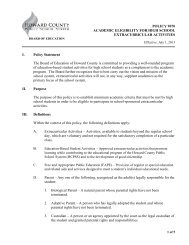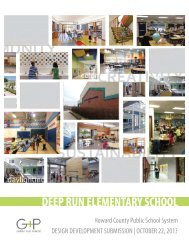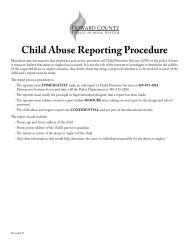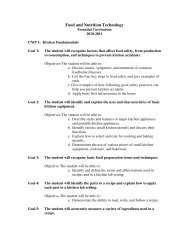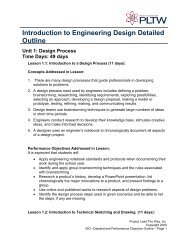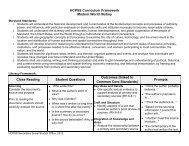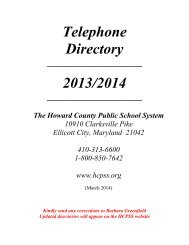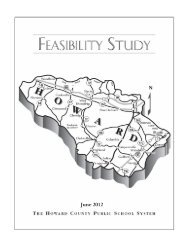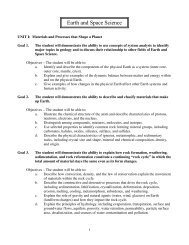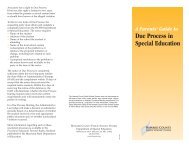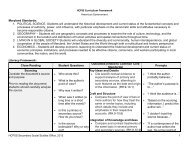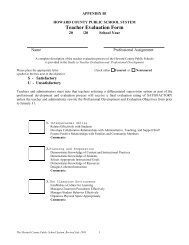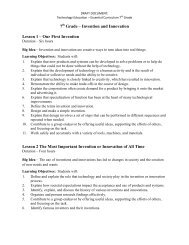Middle School Writing Stylebook - Howard County Public Schools
Middle School Writing Stylebook - Howard County Public Schools
Middle School Writing Stylebook - Howard County Public Schools
Create successful ePaper yourself
Turn your PDF publications into a flip-book with our unique Google optimized e-Paper software.
IntroductionBecoming College- and Career-Ready Writers“For students, writing is a key means of asserting and defending claims, showing what they knowabout a subject, and conveying what they have experienced, imagined, thought, and felt. To becollege- and career-ready writers, students must take task, purpose, and audience into carefulconsideration, choosing words, information, structures, and formats deliberately. They need to knowhow to combine elements of different kinds of writing—for example, to use narrative strategieswithin argument and explanation within narrative—to produce complex and nuanced writing.”Common Core State Standards for English Language Arts and Literacy in History/Social Studies, Science, andTechnical Subjects (41)The <strong>Howard</strong> <strong>County</strong> <strong>Middle</strong> <strong>School</strong> <strong>Writing</strong> <strong>Stylebook</strong> is designed to guide and standardize basicwriting expectations and stylistic elements across all middle schools for students and teachers. Thispublication is intended to be a resource for students and to supplement classroom instruction.The stylebook incorporates strategies from 6+1 Traits of <strong>Writing</strong>® by Ruth Culham, the Big6 TMinformation literacy strategies, and the HCPSS Essential Curriculum.Individual teachers in various content areas may assign additional or modified requirementsdepending on the discipline, the course, and the specific assignment.The development of this document was a team effort of the Secondary Language Arts Office andthe <strong>Middle</strong> <strong>School</strong> Instructional Team Leaders.
VoiceYour clothes show others your clothing style. The music you listen to reflects your music style. Justlike clothing and music, your writing also reflects your style. We call this your VOICE. If your namewere not on your paper, would the reader be able to recognize the paper as your paper becauseyour writing reflects your style?You might find that your voice is clearer and more visible whencomposing a narrative or creative piece of writing, but you shouldalso commit to developing your voice when constructing explanatoryand argument responses as well. Think about speaking directly toyour reader. Let your reader see YOU in your writing!How do you define your writing voice?Read this children’s nursery rhyme.Humpty Dumptysat on a wall.Humpty Dumptyhad a great fall.All the king’s horsesAnd all the king’s menCouldn’t put Humptytogether again.Now, let’s hear the same ideas presenteddifferently.1. Eggs are fragile. Unless care is taken, theycan easily break. This is what happened toHumpty Dumpty. He had a terrible,outrageously unthinkable disaster. Once whenhe was sitting leisurely on a wall, he fell. Whilean enormous number of men used theirequestrian talent, they were not able to savehis life. Humpty died.The writer records the events in a factual, almostscientific manner. His/her word choices create detailand precision. [Fragile, easily break, enormous] Thewriter’s sentence fluency reflects the writer’s abilityto deliberately infuse simple sentences [Eggs arefragile. Humpty died.] and complex sentences [Oncewhen he was sitting leisurely on a wall, he fell. Whilean enormous number of men used their equestriantalent, they were not able to save his life]. The writerdoes not rely on one type of sentence structure toconstruct meaning.2. What a silly protein! Why in his right mind wouldan egg choose to sit on a wall? Anyone with abrain knows that it doesn’t take much for anegg to break. Do eggs have brains? Humpty felland scattered, shattered like an expensive pieceof china dropped on a hot August sidewalk.That’s exactly what happened to Humpty Dumptywhen he sat on a wall. The king’s men and theirhorses had to waste their valuable time trying torevive him. There were no winners here.The writer’s word choice allows him/her torecord the events in a way which portrays him/her as knowledgeable, insightful, descriptive, andalso playful. It also appears that the writer feelscomfortable taking liberties when reaching logicalconclusions. Although the writer reports the facts,he/she does so with a measure of humor. Thewriter’s sentence fluency reflects variety; in addition,the writer includes a skillful method to engagethe reader and make the reader think. While a bitconversational at times, this tone is not distractingto the reader.6+1 Traits of <strong>Writing</strong> ® Page 5
Word choice is more than the correct use of words. A good writer selects words that are accurate in thecontext AND that communicate ideas elegantly and powerfully. Ask yourself if your words create images andemotions for your reader and make your ideas come alive.“How do I know which word to use?”Know the difference between connotation and denotation.• Connotation is the feeling a word gives a reader. Ex. bony vs. slender.• Denotation is the actual dictionary definition of the word.Use figurative language to help you describe something or someone.• Similes, metaphors, personification, and alliteration.Choose words that are appropriate for your audience and type of writing(formal or informal).• Avoid slang unless it is a character’s voice.• Use content specific vocabulary.• Use persuasive language when appropriate.Use varied and vivid word choice.Suggestions to replace “said”:Word Choiceadded urged requested mumbled grunted commanded wailed taunteddecided agreed uttered scolded nagged insisted claimed whisperedlectured explained babbled vowed shrieked objected instructedreassured mentioned estimated boasted warned stammered pleadedAvoid overused words:a lot said big run fun take pretty sitvery good got cute stuff interesting walkbad little cool tell great things sadWarning: When using a thesaurus, DO NOT OVERDO IT! Readers can tell if a worddoes not belong or if it does not match the voice of your writing. Use words thatyou “own” and understand.“Choose language that expresses ideas precisely and concisely, recognizingand eliminating wordiness and redundancy.”Common Core Language Standard 7.3.aPage 6 6+1 Traits of <strong>Writing</strong> ®
Descriptive Word ChartsWord ChoiceSoundsbang crash harsh loud quiet shrill squeak voicelessbooming crying hiss melodic raspy silent squeal wailbuzz deafening hoarse moan resonant snort thud whineclatter groan hushed mute screaming soft thump whisperedcooing growl husky purring screech splash thunderousTimeancient crawling early late noonday quick sunrise yearsannual dawn eons lengthy old rapid sunset yearlybrief daybreak evening long old-fashioned short swift youngbrisk daylight fast modern outdated slowly tardycenturies decade flash moments periodic speedy twilightcontinual dusk intermittent noon punctual sporadic whirlwindTouchboiling cool dusty frosty loose sharp slushy unevenbreezy creepy filthy grubby melted silky smooth waxenbumpy crisp fluffy hard plastic slick stinging wetchilly dirty flaky hot prickly slimy tender woodencold dry fluttering icy shaggy slippery tight yeildingSight/Appearanceadorable chubby dark foggy homely round skinny unusualalert clean deep fuzzy light rotund smoggy weirdbefuddled cloudy dim glamorous lithe pale sparkling wideblinding colorful distinct gleaming low poised spotless willowybright contoured dull glowing misty quaint steep wizenedbrilliant crinkled elegant graceful motionless shadowy stormybroad crooked fancy grotesque muddy shady straightblonde crowded filthy hazy murky sheer strangebloody crystalline flat high nervous shiny ubiquitousblushing curved fluffy hollow obtuse shallow unsightly6+1 Traits of <strong>Writing</strong> ® Page 7
Sentence FluencySentence fluency is more than the correct use of varied sentence structures. This trait describes the soundor flow of a piece of writing. Good writers use different types and lengths of sentences to enhance theirmeaning. They may even use sentence fragments for stylistic effect!“How do I make my writing sound amazing?”Have you ever closed your eyes while a good reader is reading a story aloud? How does it sound? Doesit flow, drawing you in, mesmerizing you with its music? Are there places where suddenly short, staccatosentences cause you to sit up and pay attention?Effective writers create music with their writing, whether it is an essay, a poem, or a story.Strategies to Consider• Read your writing aloud. How does it sound?Does each sentence connect smoothly tothe ones before and after?• Use clear transition words and phrases tohelp your reader follow your meaning.(See page 4.)Example: In addition to solving the crime,the young detective donated his rewardmoney to charity.• Expand short sentences by adding adjectives,adverbs, phrases, and clauses.Example: The swirling, sinister cumulousclouds nervously chased the setting sun intodarkness.• Combine short sentences into compound orcomplex sentences.• Vary sentence beginnings, middles, andendings.ExamplesOriginal sentences:Bob chased a copperhead through his yard. Bobfinally captured the snake under a bush.Revisions:1. Bob chased a copperhead through his yard,and he finally captured it under a bush.2. Bob chased a copperhead through hisyard; he finally captured it under a bush.3. After he chased a copperhead through hisyard, Bob finally captured it under a bush.4. Chasing a copperhead through his yard, Bobwondered whether he would capture it.5. Bob, an adventurous middle school student,captured a copperhead in his yard.6. Bob chased a copperhead through hisyard, finally capturing it under a bush.“Vary sentence patterns formeaning, reader/listener interest,and style.”Common Core Language Standard 6.3.aPage 8 6+1 Traits of <strong>Writing</strong> ®
ConventionsPaying attention to conventions while editing your paper carefully helps your reader immensely! Readers donot expect to see spelling or punctuation errors or run-on sentences in a published text.There are a number of ways you can check your paper for conventions. You can self edit, peer edit, use adictionary or spell checker, and use a grammar checker or language handbook. Your teacher will help youidentify conventions that you need to correct in your paper. The chart below shows standard symbols thatyour teacher may write on your paper.A Word About TitlesWhen referring to titles in your writing, be sure to use the correct form of punctuation.• Short pieces (stories, poems, songs, essays) are placed in quotation marks.“Thank you, Ma’am”• Titles of longer pieces (novels, plays, movies, CDs) are italicized. However, when you handwrite thesetitles, you must underline them.Romeo and Juliet OR Romeo and Juliet• Some titles are not punctuated, such as the Bible or government documents like the Constitution.There is a standard guide to edit your own or another’s writing. Use the symbols below, the universallanguage of editing, to highlight conventions that need to be fixed.Symbol Meaning Example CorrectionInsert letters orwordsHemingway was authorHemingway was an author. New paragraph He fell asleep.The next morning,he jumped out of bed.He fell asleep.The next morning, he jumpedout of bed.sp. Spelling error Wen are we going to leave? When are we going to leave?Make a capital letterlower case.My Mom and Dad went shopping.My mom and dad went shopping.WC Word Choice I had a good trip. WC I enjoyed a fabulous vacation.Capitalize king’s dominion is awesome. King’s Dominion is awesome.Delete a space The side walk is cracked. The sidewalk is cracked.Add punctuation(period, comma,quotation marks, etc.).Switch position ofletters or wordsI’m not going to school,”he remarked.She be will raedy soon.“I’m not going to school,” heremarked.She will be ready soon.Delete The hail in in Vale . . . The hail in Vail . . .RO or ROSRun on sentenceWe took him to the store he pickedup cereal and came home. ROWe took him to the store. Hepicked up cereal, and came home.SF or Frag Sentence Fragement Because we had to wash the car. SFNC Not Clear She found it under the thing. NCWe were late because we had towash the car.She found her journal underthe table.6+1 Traits of <strong>Writing</strong> ® Page 9
What should my assignment look like when I hand it in?Before you submit your work, you must do a final check on the presentation (the form and layout) of yourwriting. Presentation is the last step before publishing. Below is a sample of Modern Language Association(MLA) Format that is used for formal papers and research papers.MLA Format for Formal Papers+1 PresentationMy Namedouble spaceMy Teacher’s NameEnglish 625 November 2013Title of PaperText begins here.Typed Assignments• Use Times or Times New Roman font in 12-point size.• Set the margins to be one inch all around (top, bottom, left, and right sides).• Left justify your margins.• Double space everything within and between paragraphs.• Indent paragraphs appropriately.Avoid• Creases, tears, folds in assignments.• Texting abbreviations.• Fonts that do not distinguish between upper and lower case letters.Remember to take pride in each of your assignments; they are an expression of whoyou are. What do you want your work to say about YOU?“Use technology, including the Internet, to produce and publish writing andto interact and collaborate with others.”Common Core <strong>Writing</strong> Standard 6Page 10 6+1 Traits of <strong>Writing</strong> ®
Research to Build and Present Knowledge“What is research?”Research is the process of gathering information about a particular topic. We do “research” every time welook for information at the library, in a textbook, or on the Internet. We do “research” every time we ask aknowledgeable person about something they know well.In school, you are asked to research many different issues. The three major goals of research include thefollowing:• Establishing facts• Analyzing information• Reaching new conclusionsUsually, researchers share their findings with others in a variety of formats. They may write a paper, prepare anaudio-visual presentation, give a talk, or design a brochure.The research process includes a methodical approach to finding and examining a variety of reliable, scholarlyresources on a particular topic.Research GlossaryAnalysis is the close examination of information in order to understand it better and be able to draw conclusionsfrom it.Synthesis is the process of combining ideas from several sources into a new paper or product.A thesis statement tells the reader the main idea of your paper or product.A claim is a statement that reveals the writer’s opinion on a debatable or controversial topic.A counterclaim is a statement that presents the opposite viewpoint to the claim.A Works Cited page is a list of the sources that the writer actually used to create a paper or other product.An Annotated Bibliography is a list of sources with a brief summary of the information located in each source.Primary sources are artifacts created by someone who experienced events firsthand. Examples: diaries,autobiographies, photographs, works of art, stories, interviews.Secondary sources are created by using primary source material. The information is rewritten or re-packaged bya person who interprets the information. Examples: biographies, magazine articles, textbooks.Tertiary sources are very limited in the information they provide. Tertiary sources are useful when you begin tolearn about a topic. Example: almanacs, encyclopedias.Research to Build and Present Knowledge Page 11
Research to Build and Present KnowledgeCollege and Career Readiness Anchor Standards for ResearchStudents will be able to:• Conduct short as well as more sustained research projects based on focused questions,demonstrating understanding of the subject under investigation.• Gather relevant information from multiple print and digital sources, assess the credibility andaccuracy of each source, and integrate the information while avoiding plagiarism.• Draw evidence from literary or informational texts to support analysis, reflection, and research.Information Literacy Using the Big6 TMThe Big6 TM provides a process for methodically approaching a research task. There are six main steps that are usefulto follow whether you are seeking information to answer a question, to solve a problem, or to make a decision.Key research skills for students to develop are these:• How to evaluate the quality of information from a variety of sources• How to recognize information that is relevant to the task• How to synthesize information from multiple sources into a coherent piece of work1 Task Definition• Define the information problem.• Identify information needed to solve the problem.2 Information Seeking Strategies• Determine the range of all possible sources. (brainstorm)• Evaluate the different possible sources to determine priorities(select the best sources)3 Location and Access• Locate sources (intellectually and physically).• Find information within sources.4 Use of Information• Engage (e.g., read, hear, view, touch) the information in a source.• Extract relevant information from a source.5 Synthesis• Organize information from multiple sources.• Present the information.6 Evaluation• Judge the product (effectiveness).• Judge the information problem-solving process (efficiency).Page 12Research to Build and Present Knowledge
Modern Language AssociationThere are rules for informing your reader where you found the information used in any paper. In Englishclasses we use the Modern Language Association style in order to standardize the presentation of researchpapers and the documentation of sources.“Why should I document my sources?”• To give credit to the person who did the work• To show your reader where he or she can go to get more information on the topic• To justify and support your thesis or claim“How do I show my documentation?”• Be sure to include a list of Works Cited (the MLA term for a bibliography) at the end of your paper.• Be sure to provide credit in the body of your paper by using in-text or parenthetical documentation.If you include the author’s name in your sentence, you would include only the page number inparentheses. Here are some examples:o In Gifted Hands, Dr. Ben Carson describes an interesting brain phenomenon: “In plasticity, functionsonce governed by a set of cells in the brain are taken over by another set of cells” (160).o An interesting brain phenomenon is called plasticity, in which the brain adapts to surgery by allowingdifferent cells to take over when some cells are removed (Carson 160).Keep this statement in mind as you begin to develop your skills as a researcher:“…ideally, writing a research paper is intellectually rewarding: it is a form of explorationthat leads to discoveries that are new—at least to you if not to others. The mechanics ofthe research paper, important though they are, should never override the intellectualchallenge of pursuing a question that interests you (and ultimately your reader). Thispursuit should guide your research and your writing” (4-5).Source: Modern Language Association. MLA Handbook for Writers of Research Papers,7th ed. New York: Modern Language Association of America, 2009. Print.Research to Build and Present Knowledge Page 13
Reminders: MLA format requires that you include all information and punctuationexactly as shown. Double space all entries and indent the second line.Article in a Magazine or NewspaperMLA Format for Works CitedAuthor’s last name, first name. “Title of article.” Title of magazine or newspaper. Day month year: pages. Print.Isaacson, Walter. “After Williamsburg.” Time. 13 June 2008: 12-14. Print.Website Article (same as above)–See Website Entry for more detailed information.Isaacson, Walter. “After Williamsburg.” Time. Time, 13 June 2008. Web. 20 May 2009.Book by a Single AuthorAuthor’s last name, first name. Title of book. City of publication: publisher, year of publication. Print.Hemingway, Ernest. For Whom the Bell Tolls. New York: Scribner, 1940. Print.Book by Two AuthorsAuthor #1 last name, first name, and author #2 first name, last name. Title of book.City of publication: publisher, year of publication. Print.Winkler, Anthony C., and Jo Ray McCuen. <strong>Writing</strong> Research Papers: A Handbook. 2 nd ed.Washington: Harcourt, 1985. Print.Book with an EditorEditor’s last name, first name, ed. Title of book. City of publication: publisher, year of publication. Print.Miller, James, ed. The United States in Literature. Oakland, CA: Scott, Foresman, 1981. Print.[Note: If the city or publication could be confused with other cities of the same name, include the abbreviationof the state after the city.]Chapter, Poem, Short Story, Essay, or Title Section in a BookAuthor’s last name, first name. “Title of chapter, poem, etc.” Title of book.Editor [if applicable]. City of publication: publisher, year of copyright. Pages. Print.Carbin, Charles. “Exercise and Fat Control.” Fitness for Life.Ed. John Wagner, Oakland, CA: Scott, Foresman, 1979. 62-77. Print.Diagrams – Maps, Charts, etc.Author [if known]. Title of Diagram. Type of Diagram. City: Publisher, Year. Print.Washington, D.C. Map. Chicago: Rand, 1999. Print.Page 14Research to Build and Present Knowledge
MLA Format for Works CitedEncyclopedia, Reference Book EntryAuthor [if known] “Title of entry.” Title of encyclopedia. Edition. Year. Print.“Nutrition.” Encyclopedia Britannica. 10 th edition. 2003. Print.Film or Video recordingDirector’s last name, first name, dir. Title of Film or video. Perf. lead actors.Name of Studio, date of release. Film.Ross, Herbert, dir. The Turning Point. Perf. Ann Bancroft, Shirley MacLaine, Miklail Baryshnikov, and LeslieBrown. Twentieth Century-Fox, 1978. Film.Interview, published or recordedLast name, first name of person interviewed. Interview. Name of show where interview was conducted orpublication where interview was printed. Place interview was conducted. Date of interview. Medium.Gordon, Suzanne. Interview. All Things Considered. National <strong>Public</strong> Radio. WNYC, New York. 1 June 2000. Radio.Interview, personally conductedLast name, first name of person interviewed. Personal Interview. Date of interview.Moon, Mary. Personal Interview. 22 October 2002.Website or Online <strong>Public</strong>ationLast name, first name of author(s) [if available]. “Title of document.” Title of website.Publisher or sponsor of site, Date of publication. Web. Date of access. .“Fresco Painting.” Encyclopedia Britannica Online.Encyclopedia Britannica, 2002. Web. 8 May 2002 .“Chicago, Illinois.” Map. Google Maps. Google, 20 May 2009. Web. 20 May 2009Research to Build and Present Knowledge Page 15
“How can I be honorable about using information I have collectedfor assignments?”All of us have a responsibility to give credit to a source of information when we use it. If you don’t give creditto the source (whether it is an individual or a group of people), you are presenting the information as if youcreated it.This is a form of academic dishonesty with a special name—PLAGIARISM.There are two types of plagiarism:• accidental• deliberateAcademic IntegrityAccidental plagiarism is often the result of sloppy work like forgetting to put quotation marksaround text taken directly from a source, forgetting to give credit to a source that you summarized orparaphrased, not quoting accurately, or crediting the wrong source.Deliberate plagiarism means that a person has the intention of being dishonest like buying anassignment online, copying work from another student, turning in someone else’s work as his/herown, or cutting-and-pasting parts of ideas and pretending they are original.Be sure you understand how to give credit for information before you turn in an assignment.• Learn how to paraphrase.• Learn when to use a direct quotation and how to embed it within your own words.• Learn how to summarize.• Learn how to cite sources.Remember: If you copy other people’s work, you are stealing. When you do not do yourown work, you do not learn much. The further along you get in school, the harder itwill become to write your own papers and express your own thoughts effectively.Page 16Research to Build and Present Knowledge
<strong>Writing</strong> Goals Grade 6______________________________________________________________________________________________________________________________________________________________________________________________________________________________________________________________________________________________________________________________________________________________________________________________________________________________________________________________________________________________________________________________________________________________________________________________________________________________________________________________________________________________________________________________________________________________________________________________________________________________________________________________________________________________________________________________________________________________________________________End-of-year Reflection ____________________________________________________________________________________________________________________________________________________________________________________________________________________________________________________________________________________________________________________________________________________________________________________________________________________________________________________________________________________________________________________________________________________________________________________________________________________________________________________________________________________________________________________________________________________________________________________________________________________________________________________________________________________________________________________________________________________________________________________________________________________________________________________________Page 17
<strong>Writing</strong> Goals Grade 7______________________________________________________________________________________________________________________________________________________________________________________________________________________________________________________________________________________________________________________________________________________________________________________________________________________________________________________________________________________________________________________________________________________________________________________________________________________________________________________________________________________________________________________________________________________________________________________________________________________________________________________________________________________________________________________________________________________________________________________End-of-year Reflection ____________________________________________________________________________________________________________________________________________________________________________________________________________________________________________________________________________________________________________________________________________________________________________________________________________________________________________________________________________________________________________________________________________________________________________________________________________________________________________________________________________________________________________________________________________________________________________________________________________________________________________________________________________________________________________________________________________________________________________________________________________________________________________________________Page 18
<strong>Writing</strong> Goals Grade 8______________________________________________________________________________________________________________________________________________________________________________________________________________________________________________________________________________________________________________________________________________________________________________________________________________________________________________________________________________________________________________________________________________________________________________________________________________________________________________________________________________________________________________________________________________________________________________________________________________________________________________________________________________________________________________________________________________________________________________________End-of-year Reflection ____________________________________________________________________________________________________________________________________________________________________________________________________________________________________________________________________________________________________________________________________________________________________________________________________________________________________________________________________________________________________________________________________________________________________________________________________________________________________________________________________________________________________________________________________________________________________________________________________________________________________________________________________________________________________________________________________________________________________________________________________________________________________________________________Page 19
The <strong>Howard</strong> <strong>County</strong> <strong>Public</strong> <strong>School</strong> System does not discriminate on the basis of race, color, creed, national origin, religion, physical or mental disability,age, gender, marital status, or sexual orientation in matters affecting employment or in providing access to programs. For more information, contact theEquity Assurance Office of the <strong>Howard</strong> <strong>County</strong> <strong>Public</strong> <strong>School</strong> System at 10910 Clarksville Pike, Ellicott City, MD 21042 or call 410-313-6654.For further information, contact: Secondary Language Arts410.313.6620 • fax 410.313.6795<strong>Howard</strong> <strong>County</strong> <strong>Public</strong> <strong>School</strong> System10910 Clarksville Pike • Ellicott City, Maryland 21042 • www.hcpss.org



